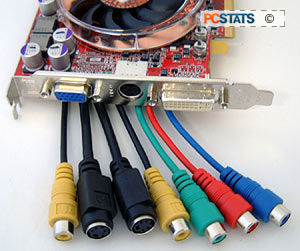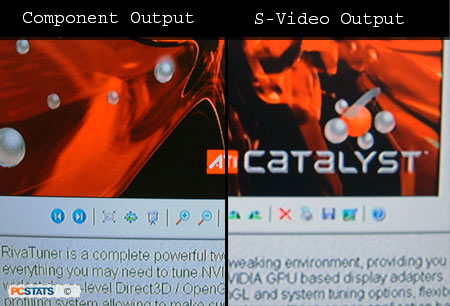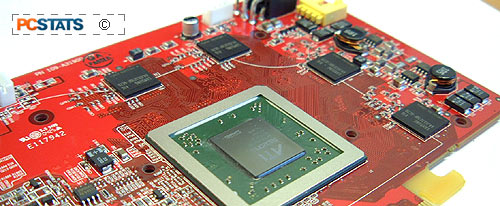
These
days it's pretty standard for a videocard to support TV-Output. With ATI's new
support of the HDTV standard, we're now starting to see videocards based
on the Radeon emerge with component output (y, Pb, Pr) instead of just the usually
accompaniment of s-video and composite (RCA).
For
comparisons sake we're going to show you the difference between traditional
S-Video output of a computer desktop to a TV screen, and the higher quality
component output. We're not going to
go into all the detail of why component output is better,
or what is supposed to be happening with HD TV, as that is
beyond the scope of this review.
Suffice
to say, below are two side by side screen captures which
illustrate the potential of component output to an HDTV capable screen in place
of the old videocard s-video output.

On the left is
component output, on the right is S-Video. As you can clearly see the text and
even image (look at the ATi logo) is much sharper and crisper because of the the
use of the component output feature. Component is clearer, and the s-video
equivalent is noticeably blurred.
Image Quality Comparison...
Image
quality is one spot where ATi has really dominated nVIDIA the last couple of
years, but with the release of the NV40, things are much closer. We're going to
compare the AA and AF quality of the MSI RX800XT-VTD256E to an Albatron GeForce
6800GT. The fact that one card uses AGP, and the other PCI Express doesn't
factor into IQ comparisons. To see an example, head on over to our recent review
of the X800XT PE right here.
Next, we'll tackle the overclockability of this MSI videocard!
Overclocking MSI's red
beauty
 Let's be
frank here, the MSI RX800XT-VTD256E is already one of the most powerful
videocards on the market, and it will easily run any game you throw at it. But, if you
want to set some 3D speed records, you're going to have to overclock.
Let's be
frank here, the MSI RX800XT-VTD256E is already one of the most powerful
videocards on the market, and it will easily run any game you throw at it. But, if you
want to set some 3D speed records, you're going to have to overclock.
Seeing as
how the Radeon X800XT
core is clocked only 20 MHz slower than the X800XT PE, I immediately raised the
core speed to 520 MHz. Without much surprise the MSI card had absolutely no
problems running at that speed. It's like getting a free upgrade!
The overclocking seemed to hit
the wall once we went past 526 MHz. Anything above that and the videocard would
lock up the system. This is quite odd, since traditionally ATi cores start to
artifact before they reach their maximum speeds.
Seeing as the RX800XT-VTD256E comes with Samsung K4J55323QF-GC20 (2ns) DDR3 DRAM,
the memory is already clocked at 500 MHz (its theoretical maximum limit). Again, things just stopped
working past 526 MHz - anything higher and 3D applications would simply lock
up!
It's
possible that ATi might be artificially limiting the overclocking speeds of the
X800XT... but the company certainly isn't confirming or denying this. Anyhow, on with the
benchmarks!
 |
| PCStats Test System Specs: |
|
system 1 |
system 2 |
| processor: |
intel pentium 4 540 |
intel pentium 4 3.0c |
| clock
speed: |
16 x 200 mhz = 3.2 ghz |
15 x 200 mhz = 3.0
ghz |
| motherboards: |
gigabyte 8anxp-d, i925x |
gigabyte 8knxp, i875p |
| videocard: |
gigabyte gv-rx60x128v
gigabyte gv-nx57128d
msi pcx5750-td128
albatron trinity pc5900
msi rx800xt-vtd256e |
ati radeon 9800xt
ati radeon 9800 pro
ati
radeon 9700 pro
asus radeon 9600xt
msi fx5950 ultra-td128
msi fx5900u-vtd256
msi
fx5900xt-vtd128
aopen geforcefx 5900xt
albatron geforce 6800gt
asus a800xt/tvd |
| memory: |
2x 256mb crucial pc4300
ddr2 |
2x 256mb corsair twinx
3200ll |
| hard
drive: |
40gb wd special
ed |
40gb wd special
ed |
| cdrom: |
msi x48 cd-rw/dvd-rom |
nec 52x cd-rom |
| powersupply: |
vantec stealth 470w |
vantec stealth 470w |
| software setup |
windowsxp build 2600
intel inf 5.02.1012
forceware 61.77 |
windowsxp build 2600
intel inf 5.02.1012
catalyst 4.8
detonator
61.77 |
| benchmarks |
3dmark2001se
codecreatures
aquamark
aquamark3
x2 the threat
ut2003
doom 3
aa test, af and
aa+af test
3dmark2001se
x2 the threat
ut2003 | |
note: the agp
and pci-e systems are different, but the results are being included for
reference.gunmetal
2 benchmarks are not available for the geforce 6800 class videocards
unfortunately. they would simply not run the benchmark.
